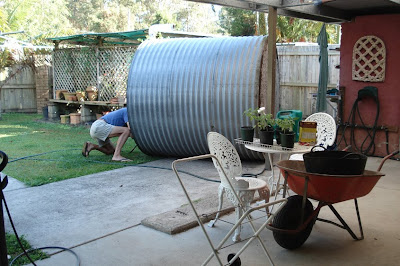Long gone are the days when we frequently replace bought items that we use at home. Hanno is on a pension and I do paid work infrequently, so the money is not there any more. Now we look after what we own. We buy the best quality we can afford then we look after it knowing that the time and effort we put in will extend the life of the product. We see this as an important part of our lives now, it certainly saves us money, but it also lightens our footprint on the earth.
This philosophy applies both inside and outside the home. We have regular times throughout the year when we check and maintain. I wrote about this recently in the spring cleaning posts. Since then one of our water tanks ran dry so it was the perfect time to tip it over, look inside and made sure everything was as it should be.
We bought this tank when we first came to live here 12 years ago. It's a 5,000 litre corrugated iron, lined tank, made locally by a small business that is no longer operating. The workmanship on the tank is excellent. All these years later, after sitting in the sun and surviving cold winters, it is still just like it was on the day we installed it.
This philosophy applies both inside and outside the home. We have regular times throughout the year when we check and maintain. I wrote about this recently in the spring cleaning posts. Since then one of our water tanks ran dry so it was the perfect time to tip it over, look inside and made sure everything was as it should be.
We bought this tank when we first came to live here 12 years ago. It's a 5,000 litre corrugated iron, lined tank, made locally by a small business that is no longer operating. The workmanship on the tank is excellent. All these years later, after sitting in the sun and surviving cold winters, it is still just like it was on the day we installed it.
Cleaning out a tank is a simple procedure. When it is completely empty, disconnect it from the downpipes, the pump and hose and then find someone to help you tip it onto its side. If you need to look inside, and Hanno always NEEDS to do this, rest it on the ground with some bricks against the side to stop it rolling. You may need your hose in hand while you do this, depending on how much gunk is in there. Have a good look, check for light coming in which will indicate a hole, or at the very least, a split in the tank.
When you've done your inspection, you can give it a good hosing and clean it out thoroughly.
The amount of gunk in there will depend on where the tank is located. If you have a lot of trees near your home, some leaves will be in the tank. Depending on the efficiency of your filter where the tank is connected to the downpipe, you'll have whatever has been on your roof since you last cleaned the tank. This might still look like leaves or bird feathers or insects or may have decomposed and settled as black silt at the bottom of the tank. I drink our tank water sometimes. I didn't like the look of that silt pouring out of the tank. But I'm still here to tell the tale so I'm either as healthy as a horse or the silt looks a lot worse than it is.
When the water starts running clear, let it drain out completely. While that is happening, check the base of the tank as well as the ground it is sitting on. Many people place their tanks on a cement base. We've always used compacted crusher dust, held in by a circle of bricks. That has done the job perfectly for us.
Then raise the tank back to its position and reconnect it to the roof and to the hose outlet and pump, if you use one. Then you just have to be patient and wait for rain to fill it up again. For me, that's the most difficult part. I like things to happen NOW.
Then raise the tank back to its position and reconnect it to the roof and to the hose outlet and pump, if you use one. Then you just have to be patient and wait for rain to fill it up again. For me, that's the most difficult part. I like things to happen NOW.
And finally, a photo of the ice cream we ate last night. Hanno said he'd been waiting for it all day after reading the blog yesterday morning. Unlike me, Hanno waits for things. :- )





